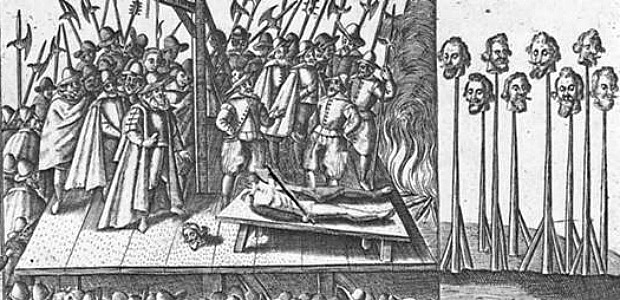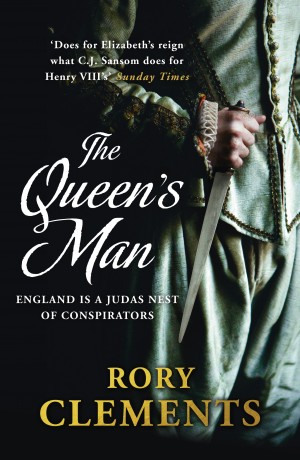You have no items in your cart. Want to get some nice things?
Go shoppingRory Clements, whose sixth book in the John Shakespeare series of Elizabethan thrillers has just been published, uncovers a deadly circle of intrigue and treason in his hero’s home town, Stratford-upon-Avon.
In October 1586 a priest named Robert Dibdale was strapped to a hurdle in the courtyard of Newgate prison. With his head close to the ground, he was dragged behind a horse along three juddering miles of potholed roads to the scaffold at Tyburn.
The traditional penalty for treason was then enacted. Didbale was hanged until judged to be almost dead, but not quite, before being cut down and laid out so that the executioner could slice open his living body – drawing out the poor man’s entrails and, finally, quartering him and holding up his head to show the crowd.
The idea of such punishment was, of course, to prolong the pain of death as a warning to other would-be traitors. One can only hope the poor man lost consciousness before the ‘Godly butchery’ began.
So who was this Dibdale and why am I particularly interested in his fate among the 250 Catholic priests and others who were executed for their faith (or treason, depending upon your point of view) during the reign of Queen Elizabeth I?
Well, he was born and raised in Shottery, just outside Stratford-upon-Avon in Warwickshire. The tiny hamlet consisted of no more than a handful of farmhouses; there wasn’t even a church.
His near neighbour there was one Anne Hathaway, who was almost exactly the same age as Dibdale, being born in 1556. Growing up in such close proximity, they must have known each other well. She would doubtless have played in the woods and field with him and his sisters Joan and Agnes.
Will Shakespeare, who was younger than Dibdale, would also have known him, for they both went to the King’s New School, where they were taught by a schoolmaster named Simon Hunt, a zealous Catholic who later became a Jesuit and went to Rome to become English Penitentiary at St Peter’s.
To Queen Elizabeth’s government, both men were enemies of the state.
Nor were these two men the only ‘dissidents’ known to Shakespeare as he grew up.
The truth is the Bard lived in dangerous times and the area of Warwickshire in which he grew up was a seething cauldron of sedition and treason. Many in the area – perhaps a majority – held to the old faith in defiance of the strict laws of the Protestant regime.
Shakespeare’s own father was a recusant – fined for not attending the official Protestant church services – so the family’s position was perilous. And this at a time when it was deemed treason to be a catholic priest or to harbour one.
So to be close to men like Dibdale and Hunt could not have been altogether healthy, especially as they were just two among a whole band of ‘traitors’ in the area – men who were either known to or related to Will Shakespeare. Men such as Robert Catesby, Edward Arden, John Somerville, Francis Throckmorton, Thomas Cottam and Dibdale, who all died violently..
Cottam and Dibdale were priests working underground to bring England back to the Catholic faith. The others were terrorists intent on assassination and revolution.
Let us examine them:
Edward Arden was a cousin to Shakespeare through his mother Mary Arden. He was a Catholic and sworn enemy of the Earl of Leicester and was implicated in the plot of his son-in-law John Somerville to kill the Queen. Arden was executed at Smithfield by hanging, drawing and quartering in December 1583. His head was placed on a pike on London Bridge. His wife, also convicted of treason, was pardoned.
Arden’s main home had been Park Hall in Castle Bromwich, 25 miles from Stratford, where he kept a priest named Hugh Hall in the guise of a gardener. Arden was a former sheriff of the county and married to Mary Throckmorton, daughter of Sir Robert Throckmorton of Coughton Court, Warwickshire. She was the sister of Anne Catesby, of Lapworth, Warwickshire, mother of the gunpowder conspirator Robert Catesby – another name that would have resonated with Shakespeare.
The would-be assassin Somerville was brought up at Edstone, six miles from Stratford, and was related to the Shakespeares through his marriage to Edward Arden’s daughter Margaret.
In 1583, he set out to kill the Queen, hoping that she would be supplanted by Mary, Queen of Scots. But even before he got to court, he boasted about his intentions to fellow guests at an inn. They testified that he said he ‘meant to shoot her and to see her head on a pole, for that she was a serpent and a viper’.
Somerville, who was probably mentally ill, was quickly arrested and, under interrogation and probably torture, confessed that he had been incited by his father-in-law Edward Arden and th priest Father Hall. At the age of 23, Somerville choked himself to death (or was murdered) in his cell before he could be executed, but his head was still severed and placed on a pole.
One who survived was Simon Hunt. From 1571-1575, he was schoolmaster at the King’s New School, where he would have known and taught William Shakespeare until he was about eleven. Hunt then went into exile, to the English College at Douai, where he was closely associated with Thomas Cottam (see below) and where they were both joined by Hunt’s former pupil Robert Dibdale.
The question is: how far was Hunt implicated in drawing the idealistic young Dibdale and Cottam to their doom?
There were two Cottam brothers. John Cottam, was one of the schoolmasters who succeeded Simon Hunt at Stratford and would have taught Shakespeare. He was elder brother to Thomas Cottam who went to Douai in 1577 and later Rome, where he became a Jesuit priest in 1580.
Thomas returned to England but was arrested on arrival at Dover. He was found to be carrying a letter and Catholic artefacts (including a crucifix and rosary beads) from Robert Dibdale to deliver to his father in Shottery. After being tortured by rack and Scavenger’s Daughter, Thomas was hanged, drawn and quartered at Tyburn in May 1582, the same year that 18-year-old Will Shakespeare got Anne Hathaway pregnant.
John Cottam left the King’s New School soon after his brother’s execution.
Next we look at Francis Throckmorton, related by marriage to Shakespeare. He was a member of the powerful Midlands family who held property in Warwickshire. Francis was brought up at Feckenham, fourteen miles from Stratford and close to the most important of the family’s homes, Coughton Court, which is associated with two great conspiracies – Francis Throckmorton’s own plot to kill the Queen and the Gunpowder Plot.
By 1580, several members of the Throckmorton family were already in trouble for persistent Catholicism and refusal to conform. Francis went to Paris where he became involved with various angry English exiles.
He returned to England and entered into secret correspondence with Mary, Queen of Scots until captured. Under torture, Throckmorton confessed to knowing of a plot by the Duke of Guise to invade England, free Mary and kill or kidnap Elizabeth. He was executed at Tyburn in July 1584.
Twenty-one years later, in 1605, Gunpowder plotters took refuge at his family’s home, Coughton Court.
Robert Catesby, leader of the Gunpowder plotters, was brought up in Lapworth, twelve miles north of Stratford. He was the son of the recusant Sir William Catesby and Anne, daughter of Sir Robert Throckmorton of Coughton Court. Robert was cousin to the conspirator Francis Throckmorton and related by marriage to Edward Arden, through whom they were all related to William Shakespeare.
The Catesby family was said to have harboured the Jesuit priest Edmund Campion before his arrest and martyrdom. It is possible that Shakespeare’s father met Campion during his visit to Warwickshire. Robert Catesby’s first taste of rebellion came in 1601 when he was part of the Earl of Essex’s ill-fated insurrection against Queen Elizabeth. He was wounded and fined £3,000.
Four years later, aged about 33, he conceived the idea of blowing up Parliament and King James. He recruited other conspirators, including Guy Fawkes, but the plot was foiled and Catesby died in a shoot-out as he tried to escape.
These were, indeed, dark days to be a Catholic in Warwickshire.
For Will Shakespeare, so close to so many men who died on the scaffold or were forced into exile, the religious strife of the late 16th century must have been alarmingly real and terrifyingly near to home.
Yes, it was a golden age, full of glamorous men and women, a time when the arts and exploration flowered like never before, but there was a dark side, too, especially if you were Catholic.
Some historians have suggested that Shakespeare may have been a crypto-Catholic. He was associated with the company of players patronised by Lord Strange, a Catholic heir to the throne who died in mysterious circumstances, and he dedicated his early work to the Earl of Southampton, who is also thought to have clung to the old faith, secretly harbouring priests at his London mansion.
Keeping such company, it is remarkable that Shakespeare himself managed to avoid the taint of treason. We can only be thankful that he did.
And maybe something positive came from it all. Perhaps it was the knowledge he gained from his dangerous liaisons that inspired his treatment of the great conspiracies in his plays: Macbeth’s plot to murder the king, the assassination of Caesar, Richard III’s murderous path to power, Iago’s devious dealings.
There’s nothing like writing about what you know…
The Queen’s Man by Rory Clements is published in hardback and ebook by Hodder & Stoughton. Buy it from Foyles.

About Rory Clements
Rory Clements lives in Norfolk and is married to the artist Naomi Clements-Wright. There are six books in the John Shakespeare series of Elizabethan mysteries: Martyr, shortlisted for the CWA John Creasey Award, Revenger, winner of the 2010 CWA Ellis Peters Historical Fiction Award, Prince, shortlisted for the 2011 Ellis Peters Historical Fiction Award, Traitor, The Heretics and The King's Man. A TV series based on the books is currently in development.





